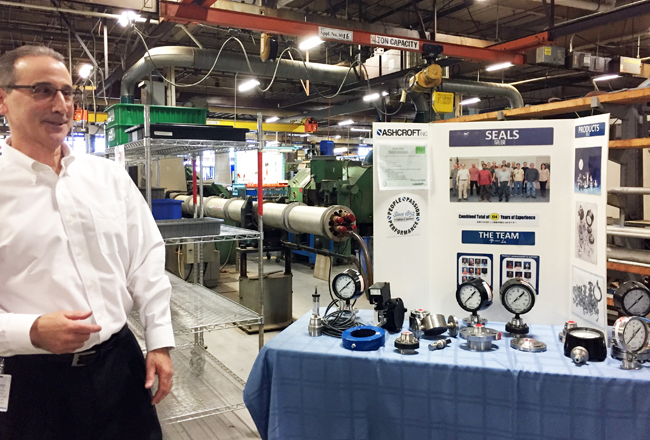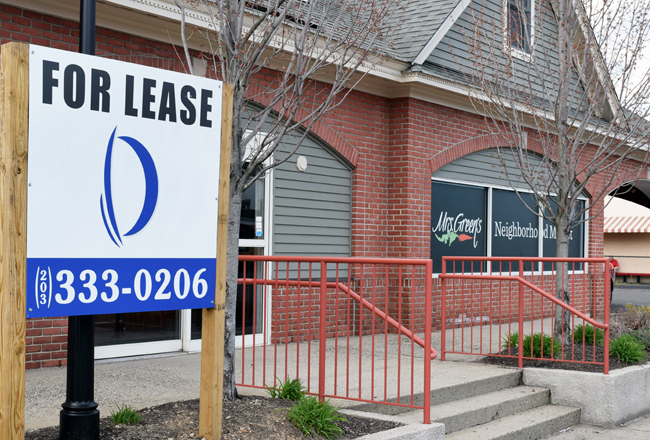
“THIS IS A FUN BUSINESS TO BE IN.” So says Steven A. Culmone, president and CEO of Ashcroft Inc., which manufactures pressure and temperature instruments such as mechanical gauges, digital indicators, transducers and transmitters and portable handheld calibrators.
Though the firm”™s headquarters is in Stratford at 250 E. Main St., it maintains a network of manufacturing facilities, sales offices and distributors worldwide, with operations in Brazil, China, Germany, Mexico and Singapore as well as joint ventures in India, Saudi Arabia and Venezuela.
As the manufacturer”™s chief executive, Culmone is racking up the miles as he makes frequent visits to each facility. “My friends always tell me how lucky I am to be going to Brazil and Germany and so on. I tell them they must not travel much,” he said with a grin.
Ashcroft”™s reach is wide. In addition to being a contractor for the U.S. Department of Defense and counting the U.S. Navy as a customer, it has clients in the biotech, shipbuilding, pharmaceutical, rail, chemical, food processing and power-generation industries, among others.
Its production is vast. The company”™s 425 Stratford employees work out of 325,000 square feet of manufacturing and office space and ship approximately 4,000 instruments a day. Culmone said Ashcroft employs about 820 people worldwide.
The scrupulously clean factory is still divided into mechanical and electronic groups, something Culmone said he wouldn”™t have predicted 15 years ago.
“We saw that the electronic business was the future a long time ago,” he said. “And digital pressure gauges have become standard in an array of industries, including the oil pressure gauge in your car,” as well as in a train-braking system in which a sensor can be activated remotely to bring the locomotive to a halt if the engineer doesn”™t respond to calls,
Still, the need for mechanical gauges will never entirely go away, Culmone said. “Say you”™re working in a building and need to check the pressure in a pipe. You can have the building supervisor tell you that according to the readout on his board, the gauges show that the pipe has been shut off. But unless you can see for yourself the actual mechanical gauge on the actual pipe, you may not feel comfortable proceeding.”
Other Ashcroft products include switches, laboratory instruments, test equipment and media isolation devices. Per-piece prices can run from 69 cents to hundreds of dollars.
Culmone said Ashcroft”™s average order is only 2½ pieces. But with 1,000 line orders a day and some 15 million end-user configurations available, that still ends up making fiscal sense. The privately held company reportedly has annual revenue of more than $1 billion.
Everything is made to order at the Stratford location, which eliminates overstocking items that may not be in regular demand. Workers are cross-trained at a number of tasks ”” from manual punching and bending metal to laser and robot welding ”” so that they can be moved around from job to job as demand ebbs and flows. “We don”™t want somebody standing at a machine with nothing to do,” Culmone said, adding that the goal is for each factory worker to be adept at 10 jobs.
Ashcroft has an average order backlog time of four hours. “With a lot of companies, that can be eight or nine months,” Culmone said. Such an approach can prove invaluable, as when a company in Texas experienced a fire that essentially wiped out all of its gauges. “They went to a competitor that said they could get them replacements in a few weeks. We turned it around in a day,” he said.
Ashcroft”™s history dates to 1852, when Edward Ashcroft, an inventor in Lynn, Massachusetts, acquired the patent rights to produce the French Bourdon tube gauge in the U.S. In 1880, he sold the company to a group of investors who eponymously renamed it Manning, Maxwell and Moore Inc. According to company lore, however, the continued popularity of the Ashcroft gauge meant that many people still referred to the firm by its former name. The star salesman for Manning Maxwell and Moore was the fabled businessman and philanthropist Diamond Jim Brady.
In 1951, MMM moved its primary manufacturing and corporate offices from Bridgeport to Stratford. The company was sold in 1964 to Dresser Industries, a Dallas-based equipment manufacturer and services provider for oilfields and the energy industry, which 10 years later added Newtown-based Heise Bourdon Tube Co. to its valve and instrument division.
Following Dresser”™s acquisition by Halliburton in 1998, its non-oilfield companies were eventually spun off as a separate unit. In 2006, the Nagano Keiki Corp. of Japan, which had already established a cooperative agreement with Ashcroft, purchased the instrument group and reestablished it as Ashcroft Inc.
Culmone said he maintains a friendly, open-door culture in the Stratford workplace. “I tell everybody that my door is open,” he said. “They can come in here and tell me I”™m doing a poor job and that I should be doing such-and-such. I might tell them to go pound sand, but it”™s always valuable to hear suggestions. That plays a huge part in how we do things.”
Ashcroft also maintains a strong good-neighbor policy, partnering with the Housatonic Community College Advanced Technology Center and the Bullard-Havens Technical High School in Bridgeport, as well as donating to charitable organizations ranging from the American Cancer Society and Special Olympics to the United Way of Coastal Fairfield County and Sterling House, a community center in Stratford.
Still, Culmone, a Wallingford resident, said that if he were looking for a location for a company”™s headquarters, “I would not see much advantage to being in Connecticut. The people here are terrific and talented and the location between New York City and Boston is good. But the taxes, the infrastructure, the general attitude towards business ”” I would be hard-pressed to make the case for coming to Connecticut as it stands now.”





















